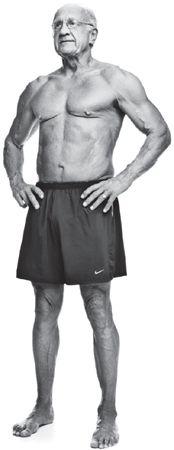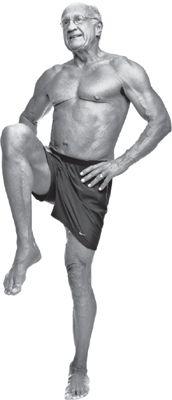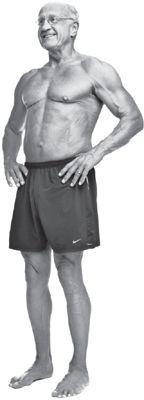The Life Plan (33 page)
Authors: Jeffry Life
Tags: #Men's Health, #Aging, #Health & Fitness, #Exercise, #Self-Help

For the past three years, I have worked on Pilates machines for one hour, three times a week. I have found that this has dramatically improved my posture, flexibility, gait, and agility. It is by far the fastest way I have found to improve flexibility and balance. Today I move faster and more youthfully than I did in my 30s. I really have become a believer that whatever your fitness level, you can begin a body-conditioning Pilates program that will help protect you from injuries, greatly improve your flexibility, and increase your strength. For more information about Pilates programs in your area, visit www.pilatesmethodalliance.org.
Martial Arts
I had been intrigued by martial arts for some time, even before my formal training began. I started training in Tae Kwon Do when I moved to Las Vegas eight years ago and am now in pursuit of a black belt. One of the major reasons I like Tae Kwon Do so much is that it demands total concentration. For a few hours each week I can block out all the pressures of my daily life. It requires focus, clarity of mind, inner peace, self-respect, respect for others, and discipline. I have found that it has greatly improved my overall motor skills, muscle memory, and quick reaction time.
Martial arts require flexibility, balance, speed, and coordination—the very things that are lost as men age. In conjunction with my complete Life Plan, including strength training, cardiovascular endurance, low-glycemic/low-fat nutrition, and correcting my hormonal deficiencies, Tae Kwon Do has helped me at age 72 do many of the things a 20-something has trouble doing. I strongly believe that martial arts have been integral to my successful healthy aging. While I’m no street fighter—and probably will never be (but who knows?)—I’ve definitely moved way beyond my father’s concept of aging.
For example, Tae Kwon Do has not only enhanced my physique, it’s improved my cognitive fitness. Several recent studies have shown a strong link between learning new and complex physical and mental skills and neuroplasticity. Neuroplasticity, also known as cortical remapping, refers to the ability of the human brain to continue to change and grow. We now know that the brain and its functions are not fixed throughout adulthood, as was once thought. Your brain can actually rewire itself, making you smarter, as it is forced to adapt to new and complex physical and mental activities. In other words, your brain’s physical anatomy and physiology can actually change, and martial arts, because of their focus on attention to detail, are one way that you can help yourself get smarter.
The value of martial arts training for me far exceeds my ability to master the intricate steps, footwork, kicking, jumping, blocking, and punching that I’ve learned as I have moved through the ranks. I believe that the overall philosophy of pushing oneself beyond personal limits, which is interwoven in all martial arts, applies to every facet of life. It is a large part of how I can keep focused on a healthy path. Tae Kwon Do and most of the other martial arts enable you to dig deep within yourself and discover an inner power—which is referred to as your “indomitable spirit”—that helps you to unite your mind and body for an unstoppable attitude about anything you decide to accomplish.
The Life Plan Balance Workout
Improving your balance requires very little extra time out of your day. Balance training should be systematic, progressive, and functional, so begin with the exercises that fit your particular balance level and work your way into the more advanced levels. You will be performing one or two of these exercises every time you train. There are three types of balance exercises, so mix them up as you see fit.
TEST YOUR ABILITY TO BALANCE
The first step toward improving your balance is to determine your current balance level. The following are some tests you can do at home. If you think your ability to balance is compromised, have someone close by watch you complete these. Time yourself to accurately document how long you were able to hold the position.

Single leg reach—stand on one leg with eyes opened or closed and extend your nonsupporting leg to the front, side, or back. Hold that position for as long as you can.

Stork test—standing with your arms out to your sides, bringing the bottom of one foot to the inside knee of the other leg and hold that position with eyes opened or closed for as long as you can.
Traditional Balance Exercises
STEP UP BALANCE
Benefits:
Improves balance, stability, and core strength.
Improves balance, stability, and core strength.
To start:
Stand in front of a step or box with your feet shoulder width apart.
Stand in front of a step or box with your feet shoulder width apart.
1.
Step onto the step with your right leg.
2.
Lift your left leg until your upper leg is parallel to the floor.
3.
Step down with both legs.
4.
Repeat steps 1 to 3 for 10 to 20 repetitions, switching legs each time.
SINGLE LEG BALANCE
Benefits:
Improves balance, stability, and core strength.
Improves balance, stability, and core strength.
To start:
Stand with your feet shoulder width apart. It’s a good idea to perform this exercise near a wall or piece of equipment in case you lose your balance.
Stand with your feet shoulder width apart. It’s a good idea to perform this exercise near a wall or piece of equipment in case you lose your balance.
1.
Slowly lift one leg off the floor, at a minimum of 6 inches. Hold this position for about 30 seconds.
2.
Lower your leg to the floor.
3.
Repeat 10 to 20 times, switching sides each time.


SINGLE LEG REACH
Benefits:
Improves balance, stability, and core strength.
Improves balance, stability, and core strength.
To start:
Stand with your feet shoulder width apart. It’s a good idea to perform this exercise near a wall or piece of equipment in case you lose your balance.
Stand with your feet shoulder width apart. It’s a good idea to perform this exercise near a wall or piece of equipment in case you lose your balance.
1.
Lift one leg about 6 inches off the floor.
2.
Extend the leg that is off the floor in front of you.
3.
Return to starting position.
4.
Repeat 10 to 20 times for each leg.
For variation you can extend the leg to the side or behind you while standing on the other leg.


SINGLE LEG DEAD LIFT
Benefits:
Improves balance, stability, and core strength.
Improves balance, stability, and core strength.
To start:
Stand with your feet shoulder width apart. It’s a good idea to perform this exercise near a wall or piece of equipment in case you lose your balance.
Stand with your feet shoulder width apart. It’s a good idea to perform this exercise near a wall or piece of equipment in case you lose your balance.
1.
Lift one leg in the air about 6 inches off the floor.
2.
Lean forward at the waist, keeping your back straight.
3.
Continue to bend at the waist until your upper body is parallel with the floor.
4.
Return to starting position.
5.
Repeat 10 to 20 times with each leg.
When you have mastered this exercise and are ready to progress to a more advanced level, you can hold two dumbbells. Start with light weights and increase the weight very slowly over several weeks. Be sure to keep the dumbbells close to your body as you bend at the waist.
SINGLE LEG SQUAT
Benefits:
Improves balance, stability, and core strength.
Improves balance, stability, and core strength.
To start:
Stand with your feet shoulder width apart. It’s a good idea to perform this exercise near a wall or piece of equipment in case you lose your balance. It’s okay to hold on to a railing or sturdy support while performing this exercise.
Stand with your feet shoulder width apart. It’s a good idea to perform this exercise near a wall or piece of equipment in case you lose your balance. It’s okay to hold on to a railing or sturdy support while performing this exercise.
Other books
Life Is a Serious Business by Anne Butler
The Last Good Knight Part I: Scars and Stripes (The Original Sinners) by Reisz, Tiffany
The Theory of Games by Ezra Sidran
Salvation by Land, Alexa
Taken for English by Olivia Newport
Invitation to a Beheading by Nabokov, Vladimir
Dead Wrong by Mariah Stewart
The Driver by Mark Dawson
Witchling (Chronicles of Witchood) by Genevieve Heart
Murder Comes by Mail by A. H. Gabhart